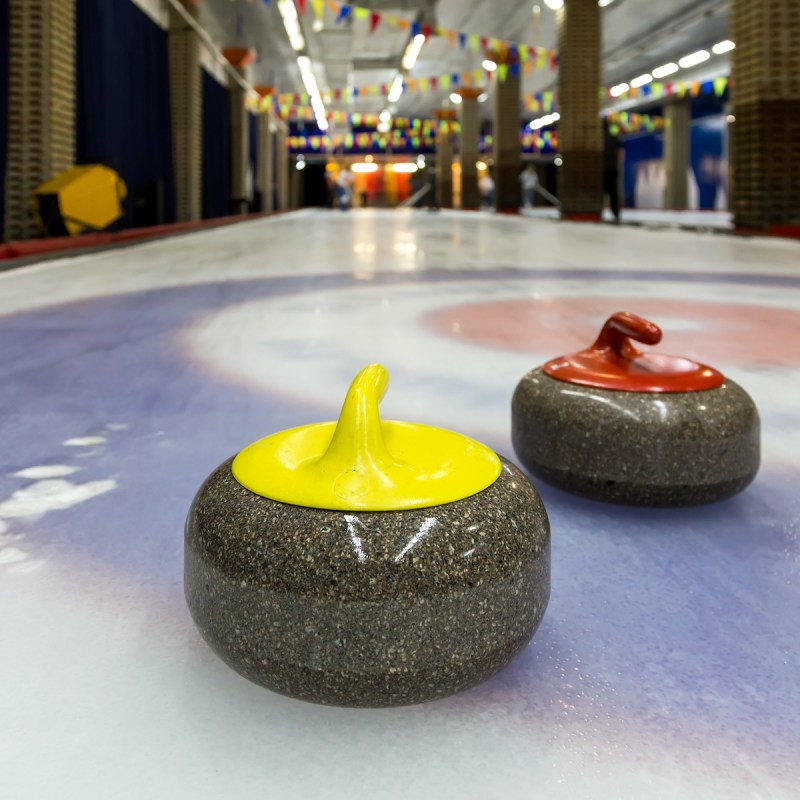
When I watch the Winter Olympics, I’m in awe of the athleticism, stamina, gutsiness, years of practice, perseverance, and sacrifice of the athletes. I was fortunate to attend the Winter Olympics in Vancouver, British Columbia, in 2010 and see everything from ski jumping to curling — a 16th-century sport started in Scotland and permanently added to the Olympics in 1998.
Videos by TravelAwaits
Considering most Olympic athletes start young, at age 59, I’m easily 50 years too late to become the next Mikaela Shiffrin or Chloe Kim. And I’m not brave enough to go hurtling down a tubular ice highway during Utah’s Bobsled Experience. Curling, on the other hand, looked doable and survivable even for a not-so-gifted athlete like me.
After a search for local curling clubs, I found the Curling Club of Houston. They were offering introductory curling classes during the Olympics and the classes were filling fast. I signed up immediately, before the “What ifs?” took over. What if I can’t stand up on the ice? (I could. I’m in decent shape thanks to bicycling.) But what if I’m not strong enough to push the granite stone? (I was). And the dreaded, What if I’m the oldest one there? (I wasn’t).
Many of us first-timers were in the 50+ group. This isn’t unique. An internet search confirmed the sport is popular with people over 50. In fact, news reports in advance of the Olympics interviewed curlers in their 80s in Utica, New York.
Curling offers long-term enjoyment no matter our ages, fitness levels, or athletic abilities. It’s a sport you’ll get better at over time and it’s a sport that pays dividends. It provides regular physical exercise, a chance to exercise your brain, social engagement, and camaraderie.
Here are some reasons I believe this Olympic sport is popular with folks over age 50:

It’s A Come-As-You-Are Sport
An email from Carl Schaeper, the curling club’s president, spelled out what to wear: tennis shoes or soft-soled shoes and stretchy or loose-fitting pants that allowed me to move easily. That was it.
The club provided the granite stones, brooms (bristleless ones that look more like a cloth-covered sponge mop), a hack (the starting block), and a Teflon sole you wear under your shoe that helps your glide easily on the ice when you throw (slide) the rock.
The club provided props to help us maintain balance as we glided on the ice to throw the stone. Players with experience use their brooms for balance.

It’s A Sport You Can Learn Quickly
In the 2-hour introductory course, we received a safety briefing then hit the ice. We spent about an hour learning the basics, including the game’s layout. The ice playing field is called a sheet. Each end of the rectangular sheet has a 12-foot diameter bullseye target called a house. Before the game begins, water is sprayed over the ice, creating a slightly pebbled texture. The pebbling provides traction for players and friction against the sliding rock.
We practiced getting in a proper position to throw the rock by using PVC pipe props, working our way up to throwing the actual rock. We learned how to sweep our teammate’s rock, too.
After working on these skills, we spent the next hour playing a few games, learning a bit of strategy, and learning how to score.
All 20 participants in the class were able to move beyond learning basic techniques to playing a few games, called ends. Some appeared to be naturals. I wasn’t a natural but that didn’t diminish the fun. I showed modest improvement by the end of the class and am aiming for the very senior Olympics in 20 years or so.

It’s More Finesse Than Brute Strength
I don’t have the greatest upper body strength and worried I wouldn’t be able to get the hefty granite rock, weighing between 38 and 44 pounds, anywhere near the house. I was surprised to learn that throwing (sliding) the rock to reach the target is about skill, finesse, and getting a feel for the force needed. It’s surprisingly easy to overshoot the house.
Even though the house is about 100 feet away, the rock easily glides over the ice without a big effort on your part. Your teammates sweep the ice, warming the surface and encouraging the rock to move forward along a particular path. Keeping up with a sliding rock and sweeping its path is a workout.
It’s A Sport Geared Toward Lifelong Learning
Curling is all about strategy and offers a mental workout. Placing a stone in the button is the goal. The one-foot diameter button is the innermost circle of the house. After each team has thrown (slid) their eight stones, the team with a stone nearest the button scores with one point for each of their stones that are closer than the opposing team’s stones.
With that goal in mind, teams can push their competitors’ stones out or set up a screen of stones to protect one of their own that is already in the house. Multiple strategies that evolve while the game is played keep it fresh and interesting. The sport is one geared toward continual learning, much like mastering chess or bridge.

It’s A Sport Of Inclusivity
Not only does the sport appeal to all ages from teens to older adults, but equipment adaptations allow differently abled curlers to participate. People who use wheelchairs and those who are unable to push the stone from a crouched position can use a specially designed stick to push the stone. Certain venues also accommodate deaf or blind participants.
Unlike other sports in which players might be sidelined by arthritic hips or knee replacements, equipment adaptations allow play to continue without diminishing the experience.
It’s All About Sportsmanship And Socializing
Opposing team members celebrate great rock throws and strategic moves. The atmosphere is collegial. This continues to the end of the games. The winning team buys the first round of beer or beverages.
With the advent of COVID, the Curling Club of Houston moved their post-game festivities outdoors where they have a weather-dependent picnic lunch and enjoy the good company.

One Drawback
I like everything about the sport and the people I met during the introductory class. I signed up on the spot to attend a four-week course to learn more. The drawback: The southwestern Houston ice rink is 50 miles from my home in The Woodlands. But it’s worth the drive.
With any luck, you’ll find a club nearer to you by searching USA Curling or Curling Canada.
Pro Tip: In addition to wearing sneakers or soft-soled shoes and stretchy clothing, dress in layers. Despite standing on ice, once you begin to play you’ll get warm, especially while sweeping.
Inspired? These articles may pique your interest, too:
